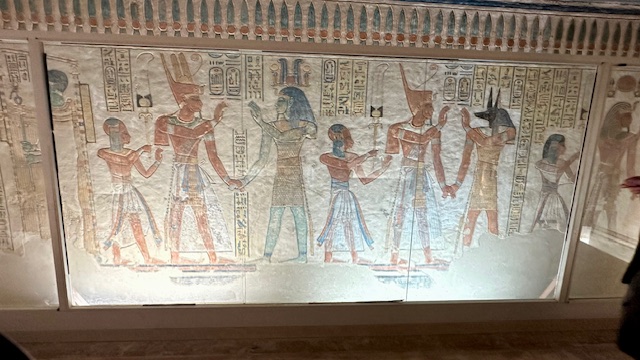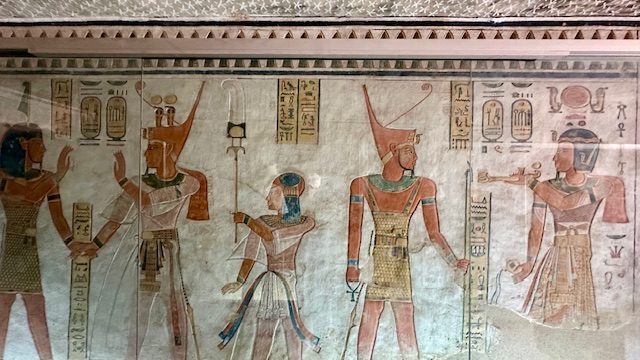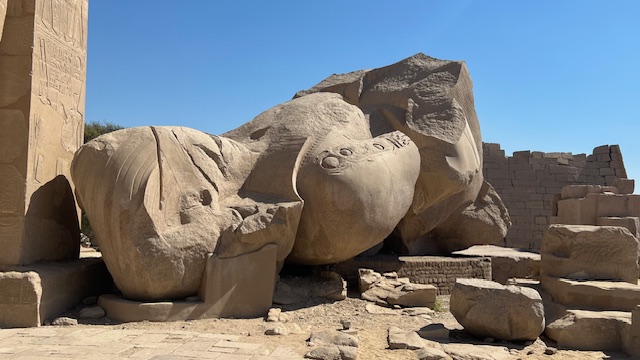We got up quite early since we had to take a 6 am flight to Luxor. It was an hour on the plane from Cairo to Luxor. We were picked up at the airport by a tour manager assigned to take care of us in Luxor. We were also introduced to our tour guide who would be with us for the next 5 days.

The Nile splits Luxor into : East and West bank.
- Luxor West Bank – This is where ancient Egyptians buried their dead and the sun sets here. This is also where you have the tombs and mortuary temples like the Valley of Kings/Queens, Temple of Hatshepsut, Medinet Habu, and Ramesseum.
- Luxor East Bank – The Luxor town where most Egyptians live and work, is on the East bank. Hotels, restaurants, as well as the temples of Karnak and Luxor are all located on the East bank.
We had a busy day visiting sites on Luxor’s West Bank on this day:
- Medinet Habu
- Valley of Queens
- Ramesseum
Medinet Habu – Commissioned by Ramesses III, this impressive temple has its pylon and many of its walls still intact and much more of the original painting visible on its carved surfaces than any of the other temples in Egypt. The temple has several courtyards, hypostyle halls, huge columns with colorful and well preserved reliefs.





The Valley of Queens was the burial site of the wives of the pharaohs. The tombs here are smaller and lack some of the grandeur of the tombs in the Valley of the Kings, except for the Tomb of Queen Nefertari. A total of almost 80 tombs are now known, most of them excavated by an Italian expedition led by E. Schiaparelli between 1903 and 1905. Only four tombs are open for public viewing, which includes the famed Tomb of Queen Nefertari, only reopened in 2016.
In all the tombs, the reliefs on the walls of the tomb was to create a pleasant afterlife for the dead person and prepare them for the next world. Personal possessions was buried with them for use in the afterlife.
Queen Nefertari Tomb – This tomb with its brilliant and exquisite images stand testimony to the creative genius of ancient Egyptian artists. From the wall images one can see the story of Nefatari’s journey to the hereafter unfold.




Tomb of Prince Amen-her-khopshef – A son of Ramses III, this prince died while still a teenager. The wall paintings of this tomb chambers have well-preserved colors.



Tomb of Khaemwaset (another son of Ramses III) contains some interesting preserved scenes. It is believed that he was probably Ramesses III’s oldest son, and the latest information indicates that his mother was probably Queen Tyti. It is not clear why his father’s brother rather than he ascended the throne after Ramesses III’s death. Images here depict similar scenes to other tombs. King offerings to God.


Tomb of Queen Titi – Titi was royalty in the 20th Dynasty but little is known about her apart from the fact that she held the title of queen. Her tomb is smaller in scale than many royal tombs and it was badly damaged and the images here are quite faded.


Ramesseum – The great mortuary temple was built by Ramesses II and dedicated to god Amun, lies on Luxor’s West Bank. Although only about half of the original structure survives, it is still a highly impressive monument. The North Tower and South Tower are inscribed with reliefs of Ramses II battle with the Hittites, similar to the reliefs of Abu Simbel. Inside the First Court are the remains of a colossal figure of the king Ramesses II, which is estimated to have originally had a total height of 17.5 meters and to have weighed more than 1,000 tons.




We then came back to our hotel which was located on the banks of Nile. Had a relaxed rest of the day ending with dinner at an Indian restaurant within walking distance of our hotel.